Numerical and Experimental Research on Identifying a Delamination in Ballastless Slab Track
Abstract
1. Introduction
2. Principles of the TFM and the Wavenumber Method
2.1. Sound Field Transmission and Reception
2.2. Principle of the TFM
2.3. Principle of the Wavenumber Method
3. Numerical Simulation
3.1. Finite Element Model
3.2. FEM Results
3.2.1. Snapshots of the Wavefield
3.2.2. FEM Results
4. Experimental Verification
4.1. Experimental Setup
4.2. Experimental Results
4.2.1. Removing Surface Wave
4.2.2. Experimental Results
5. Discussion
6. Conclusions
- (1)
- The test result has been distinctly improved as the near-surface pseudomorphism is restrained by applying the technique of removing the surface wave.
- (2)
- Compared to TFM, the wavenumber method can provide with the better computational performance and the lateral resolution. However, they have no significant difference in the longitudinal resolution.
- (3)
- It can be observed that the delamination is conspicuous while the bottom of bed plate is obscure in the image. The explanation could be the inhomogeneous propagation speed and the attenuation existed in concrete.
- (4)
- The test result is relevant to the amount of transducers. Generally, the more the transducers are, the better test result can be achieved.
- (5)
- The low frequency air-coupled ultrasonic inspection combined with Lamb wave is viewed as a preliminary step for obtaining the location of the delamination in the transversal direction.
- (6)
- Compared with the classical delay-and sum (DAS) method, the wavenumber method can greatly reduce the computational time while retaining a relatively favorable accuracy.
7. Future Work
Author Contributions
Funding
Conflicts of Interest
References
- Yu, Z.; Xie, Y.; Shan, Z.; Li, X. Fatigue performance of CRTS III slab ballastless track structure under high-speed train load based on concrete fatigue damage constitutive law. J. Adv. Concr. Technol. 2018, 16, 233–249. [Google Scholar] [CrossRef]
- Chen, L.; Chen, J.; Wang, J. Calculation of Reasonable Tension Value for Longitudinal Connecting Reinforcement of CRTS II Slab Ballastless Track. Appl. Sci. 2018, 8, 2139. [Google Scholar] [CrossRef]
- Shan, Y.; Zheng, S.; Zhang, X.; Luo, W.; Mao, J.; Kong, D. Fatigue Performance of the CA Mortar Used in CRTS I Ballastless Slab Track under Simulated Servicing Condition. Materials 2018, 11, 2259. [Google Scholar] [CrossRef] [PubMed]
- Cao, S.; Zhai, S.; Dai, F.; Deng, S.; Wang, W. Hydrodynamic Pressure and Velocity Distributions in the Interlayer Crack of Ballastless Track under High-Speed Train Load: A Theoretical Analysis. Math. Probl. Eng. 2018, 3187979. [Google Scholar] [CrossRef]
- Yang, R.; Li, J.; Kang, W.; Liu, X.; Cao, S. Temperature Characteristics Analysis of the Ballastless Track under Continuous Hot Weather. J. Transp. Eng. Pt A-Syst. 2017, 143, 04017048. [Google Scholar] [CrossRef]
- Liu, J.; Wen, X.; Zhang, Z.; Li, S.; Zeng, Z. Influence of the Stabilizer on Interfacial Bonding Behavior of Cement Asphalt Mortar in Slab Ballastless Track. J. Mater. Civ. Eng. 2018, 30, 04018245. [Google Scholar] [CrossRef]
- Tasker, L.; Karrech, A.; Shragge, J.; Josh, M. Time-lapse monitoring of internal alteration of a concrete structure using ground penetrating radar. Constr. Build. Mater. 2018, 191, 300–310. [Google Scholar] [CrossRef]
- Cassidy, N.J.; Eddies, R.; Dods, S. Void detection beneath reinforced concrete sections: The practical application of ground-penetrating radar and ultrasonic techniques. J. Appl. Geophys. 2011, 74, 263–276. [Google Scholar] [CrossRef]
- Omar, T.; Nehdi, M.L.; Zayed, T. Infrared thermography model for automated detection of delamination in RC bridge decks. Constr. Build. Mater. 2018, 168, 313–327. [Google Scholar] [CrossRef]
- Hiasa, S.; Birgul, R.; Catbas, F.N. A data processing methodology for infrared thermography images of concrete bridges. Comput. Struct. 2017, 190, 205–218. [Google Scholar] [CrossRef]
- Ongpeng, J.; Oreta, A.W.C.; Hirose, S. Characterization of Damage Using Ultrasonic Testing on Different Types of Concrete. Mater. Eval. 2018, 76, 1532–1541. [Google Scholar]
- Hong, S.; Wiggenhauser, H.; Helmerich, R.; Dong, B.; Dong, P.; Xing, F. Long-term monitoring of reinforcement corrosion in concrete using ground penetrating radar. Corrosion Sci. 2017, 114, 123–132. [Google Scholar] [CrossRef]
- Tran, Q.H.; Huh, J.; Mac, V.H.; Kang, C.; Han, D. Effects of rebars on the detectability of subsurface defects in concrete bridges using square pulse thermography. NDT E Int. 2018, 100, 92–100. [Google Scholar] [CrossRef]
- Huh, J.; Mac, V.H.; Tran, Q.H.; Lee, K.Y.; Lee, J.I.; Kang, C. Detectability of Delamination in Concrete Structure Using Active Infrared Thermography in Terms of Signal-to-Noise Ratio. Appl. Sci. 2018, 8, 1986. [Google Scholar] [CrossRef]
- Rocha, J.H.A.; Póvoas, Y.V.; Santos, C.F. Detection of Delaminations in Sunlight-Unexposed Concrete Elements of Bridges Using Infrared Thermography. J. Nondestruct. Eval. 2019, 38, 8. [Google Scholar] [CrossRef]
- Tong, J.H.; Chiu, C.L. Elastic-wave-based synthetic aperture focusing technique imaging system for detecting voids inside concrete structures. Struct. Control. Health Monit. 2017, 24, e1956. [Google Scholar] [CrossRef]
- Ganguli, A.; Rappaport, C.M.; Abramo, D.; Fascetti, S.W. Synthetic aperture imaging for flaw detection in a concrete medium. NDT E Int. 2012, 45, 79–90. [Google Scholar] [CrossRef]
- Tseng, P.Y.; Chang, Y.F.; Lin, C.M.; Nien, W.J.; Chang, C.H.; Huang, C.C. A Study of Total Focusing Method for Ultrasonic Nondestructive Testing. J. Test. Eval. 2013, 41, 557–563. [Google Scholar] [CrossRef]
- Huggett, D.J.; Dewan, M.W.; Wahab, M.A.; Okeil, A.; Liao, T.W. Phased Array Ultrasonic Testing for Post-Weld and OnLine Detection of Friction Stir Welding Defects. Res. Nondestruct. Eval. 2017, 28, 187–210. [Google Scholar] [CrossRef]
- Grohmann, M.; Mueller, S.; Niederleithinger, E.; Sieber, S. Reverse time migration: Introducing a new imaging technique for ultrasonic measurements in civil engineering. Near Surf. Geophys. 2017, 15, 242–258. [Google Scholar]
- Choi, H.; Popovics, J.S. NDE Application of Ultrasonic Tomography to a Full-Scale Concrete Structure. IEEE Trans. Ultrason. Ferroelectr. Freq. Control 2015, 62, 1076–1085. [Google Scholar] [CrossRef] [PubMed]
- Khalili, P.; Cawley, P. Excitation of Single-Mode Lamb Waves at High-Frequency-Thickness Products. IEEE Trans. Ultrason. Ferroelectr. Freq. Control 2016, 63, 303–312. [Google Scholar] [CrossRef] [PubMed]
- Li, J.; Lu, Y.; Guan, R.; Qu, W. Guided waves for debonding identification in CFRP-reinforced concrete beams. Constr. Build. Mater. 2017, 131, 388–399. [Google Scholar] [CrossRef]
- Song, H.; Popovics, J.S. Characterization of steel-concrete interface bonding conditions using attenuation characteristics of guided waves. Cem. Concr. Compos. 2017, 83, 111–124. [Google Scholar] [CrossRef]
- Schabowicz, k. Ultrasonic tomography-The latest nondestructive technique for testing concrete members Description, test methodology, application example. Arch. Civ. Mech. Eng. 2014, 14, 295–303. [Google Scholar] [CrossRef]
- Beniwal, S.; Ghosh, D.; Ganguli, A. Ultrasonic imaging of concrete using scattered elastic wave modes. NDT E Int. 2016, 82, 26–35. [Google Scholar] [CrossRef]
- Hoegh, k.; Khazanovich, L. Extended synthetic aperture focusing technique for ultrasonic imaging of concrete. NDT E Int. 2015, 74, 33–42. [Google Scholar] [CrossRef]
- Caulder, A. Full Matrix Capture and Total Focusing Method: The Next Evolution in Ultrasonic Testing. Mater. Eval. 2018, 76, 591–597. [Google Scholar]
- Bazulin, E.G. Reconstruction of reflector images using the C-SAFT method with account for the anisotropy of the material of the test object. Russ. J. Nondestr. Test. 2015, 51, 217–226. [Google Scholar] [CrossRef]
- Lin, L.; Cao, H.; Luo, Z. Total focusing method imaging of multidirectional CFRP laminate with model-based time delay correction. NDT E Int. 2018, 97, 51–58. [Google Scholar] [CrossRef]
- Hunter, A.J.; Drinkwater, B.W.; Wilcox, P.D. The Wavenumber Algorithm for Full-Matrix Imaging Using an Ultrasonic Array. IEEE Trans. IEEE Trans. Ultrason. Ferroelectr. Freq. Control 2008, 55, 2450–2462. [Google Scholar] [CrossRef] [PubMed]
- Moghimirad, E.; Villagómez Hoyos, C.A.; Mahloojifar, A.; Asl, B.M.; Jensen, J.A. Synthetic Aperture Ultrasound Fourier Beam formation Using Virtual Sources. IEEE Trans. Ultrason. Ferroelectr. Freq. Control 2016, 63, 2018–2030. [Google Scholar] [CrossRef] [PubMed]
- Chew, W.C. Waves and Fields in Inhomogeneous Media; IEEE Press: Piscataway, NJ, USA, 1994. [Google Scholar]
- Fateri, S.; Boulgouris, N.V.; Wilkinson, A. A two-dimensional fast Fourier transform using incremented frequency measurement for guided wave analysis. Insight 2014, 56, 499–504. [Google Scholar] [CrossRef]
- Lee, C.; Park, S. Flaw Imaging Technique for Plate-Like Structures Using Scanning Laser Source Actuation. Shock Vib. 2014, 9, 1–14. [Google Scholar] [CrossRef]
- Li, Z.; Wang, J.; Liu, Q.H. Interpolation-Free Stolt Mapping for SAR Imaging. IEEE Geosci. Remote Sens. Lett. 2014, 5, 926–929. [Google Scholar] [CrossRef]
- Moghimirad, E.; Mahloojifar, A.; Mohammadzadeh, A.B. Computational Complexity Reduction of Synthetic Aperture Focus in Ultrasound Imaging Using Frequency-Domain Reconstruction. Ultrasonic Imaging 2016, 38, 175–193. [Google Scholar] [CrossRef] [PubMed]
- Fan, G.; Zhang, H.; Zhang, H.; Zhu, W.; Chai, X. Lamb Wave Local Wavenumber Approach for Characterizing Flat Bottom Defects in an Isotropic Thin Plate. Appl. Sci. 2018, 8, 1600. [Google Scholar] [CrossRef]
- Lin, S.; Shams, S.; Choi, H.; Azari, H. Ultrasonic imaging of multi-layer concrete structures. NDT E Int. 2018, 98, 101–109. [Google Scholar] [CrossRef]
- Losada, R.A.; Pellisier, V. Designing IIR Filters with a Given 3-dB Point. IEEE Signal Process. Mag. 2005, 22, 95–98. [Google Scholar] [CrossRef]
- Petro, J.T.; Kim, J. Detection of delamination in concrete using ultrasonic pulse velocity test. Constr. Build. Mater. 2012, 26, 574–582. [Google Scholar] [CrossRef]
- Sunarsa, T.Y.; Aryan, P.; Jeon, I.; Park, B.; Liu, P.; Sohn, H. A Reference-Free and Non-Contact Method for Detecting and Imaging Damage in Adhesive-Bonded Structures Using Air-Coupled Ultrasonic Transducers. Materials 2017, 10, 1402. [Google Scholar] [CrossRef] [PubMed]
- Chen, J.; Yang, C.; Guo, Q. Evaluation of surface cracks of bending concrete using a fully non-contact air-coupled nonlinear ultrasonic Technique. Mater. Struct. 2018, 51, 104. [Google Scholar] [CrossRef]
- Asadollahi, A.; Khazanovich, L. Analytical reverse time migration: An innovation in imaging of infrastructures using ultrasonic shear waves. Ultrasonics 2018, 88, 185–192. [Google Scholar] [CrossRef] [PubMed]



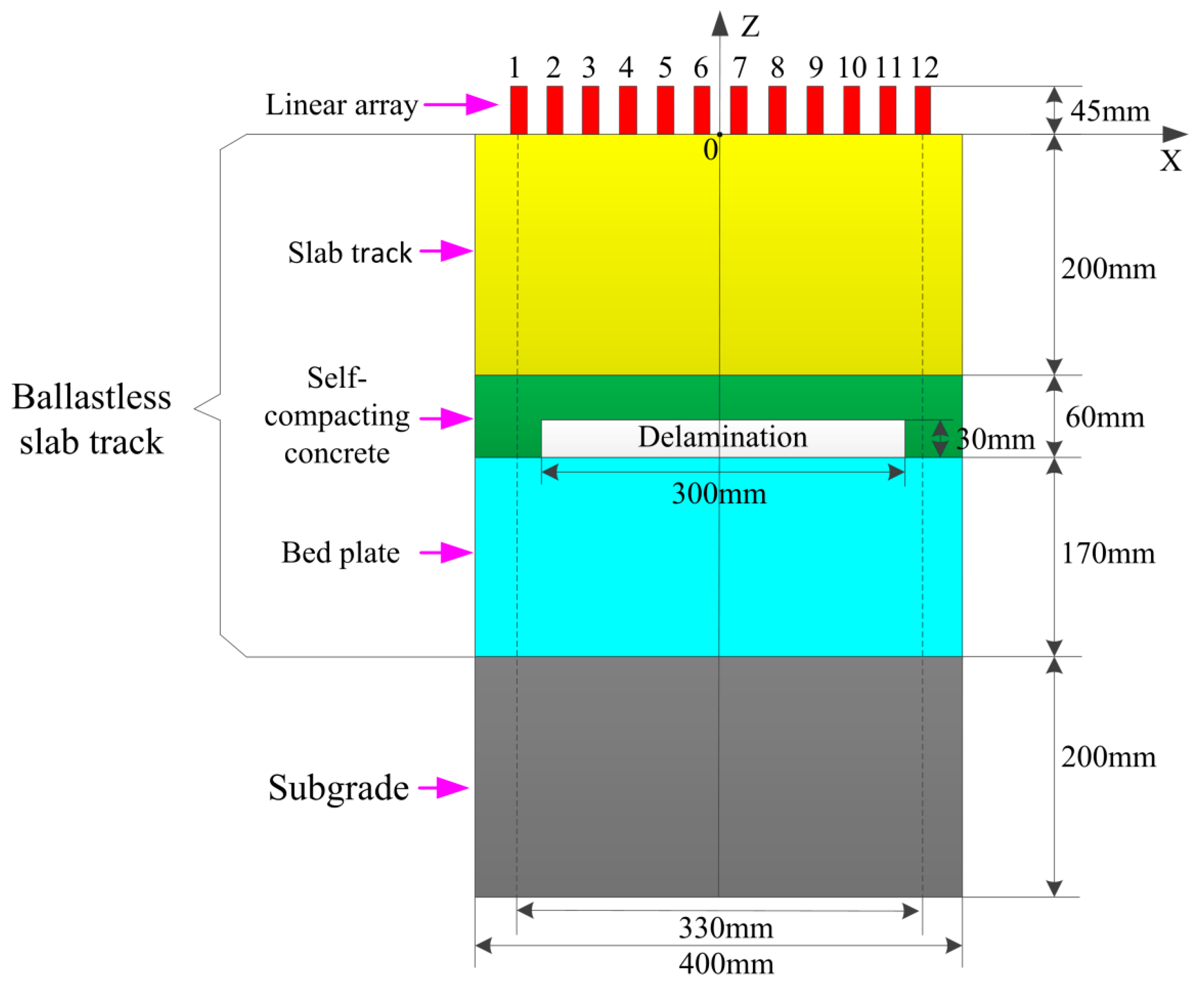



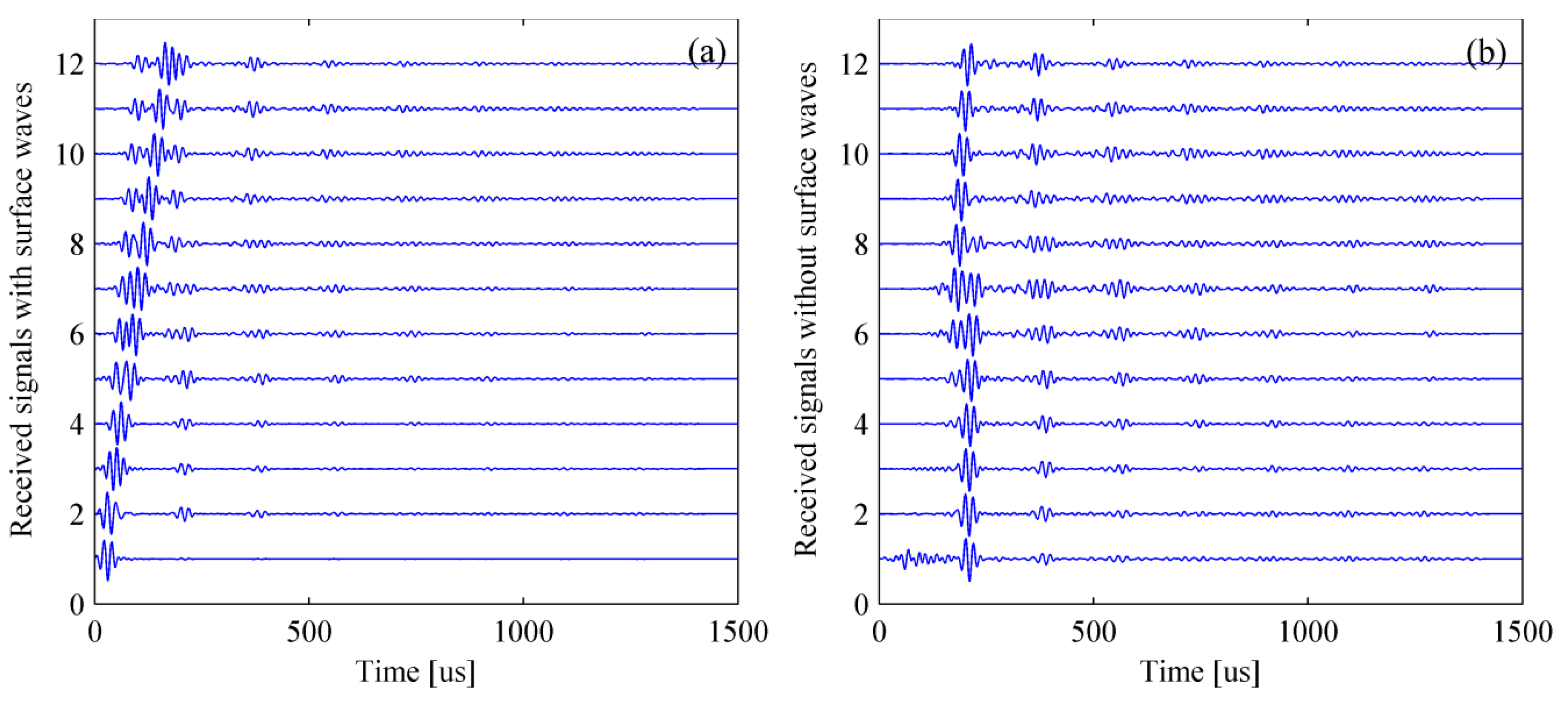
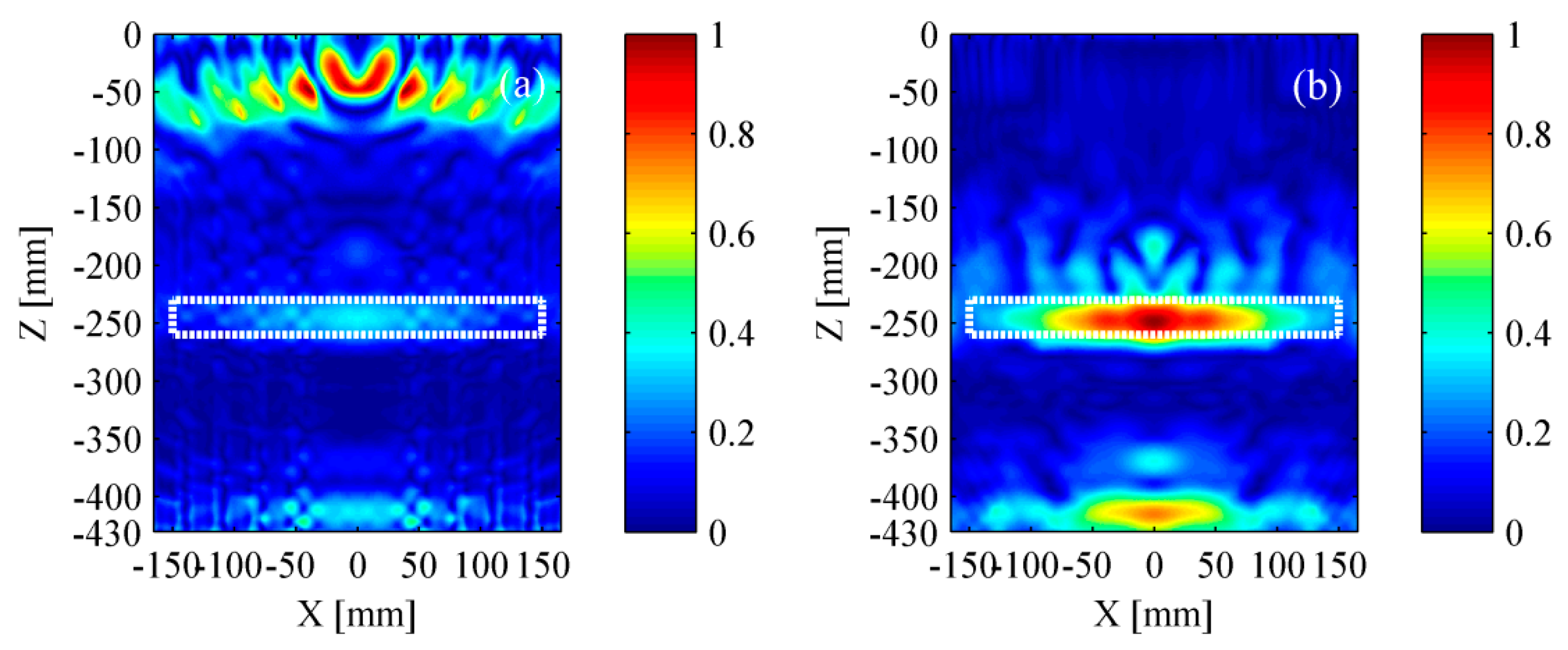
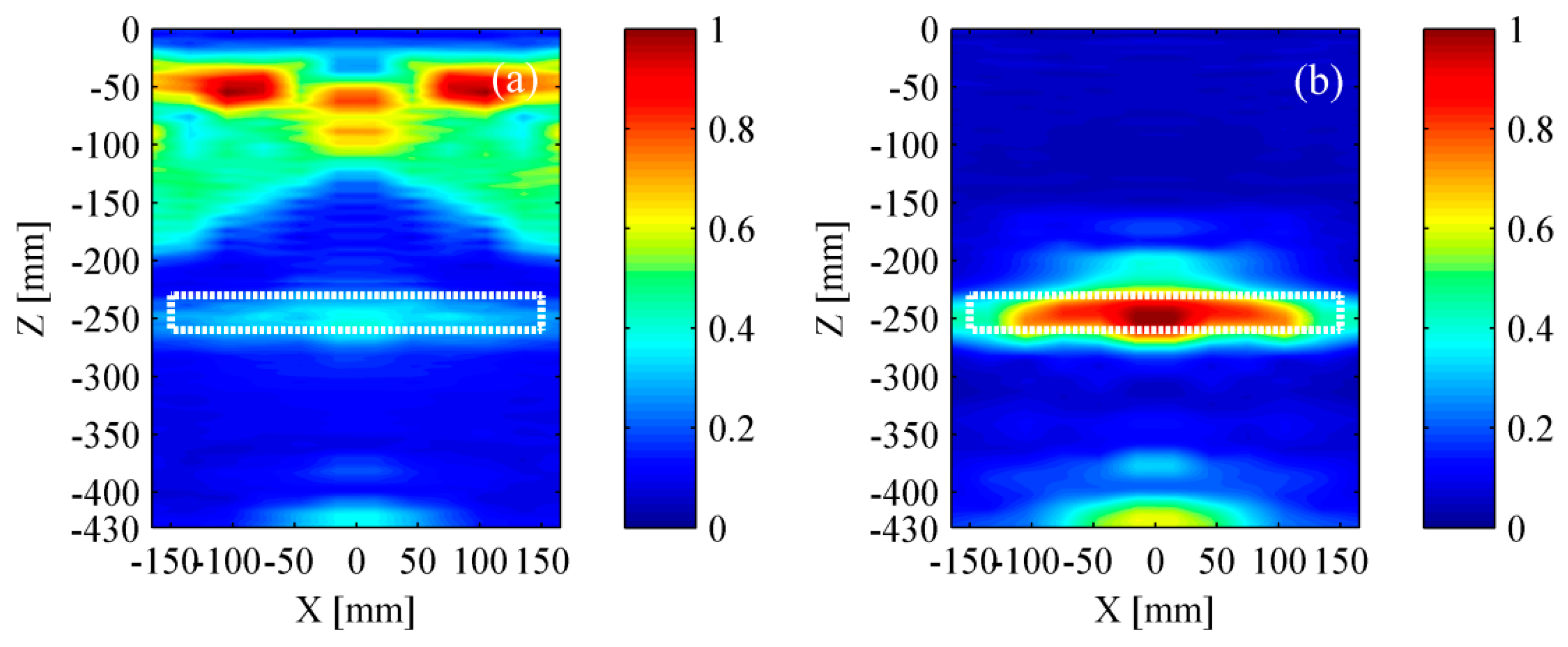

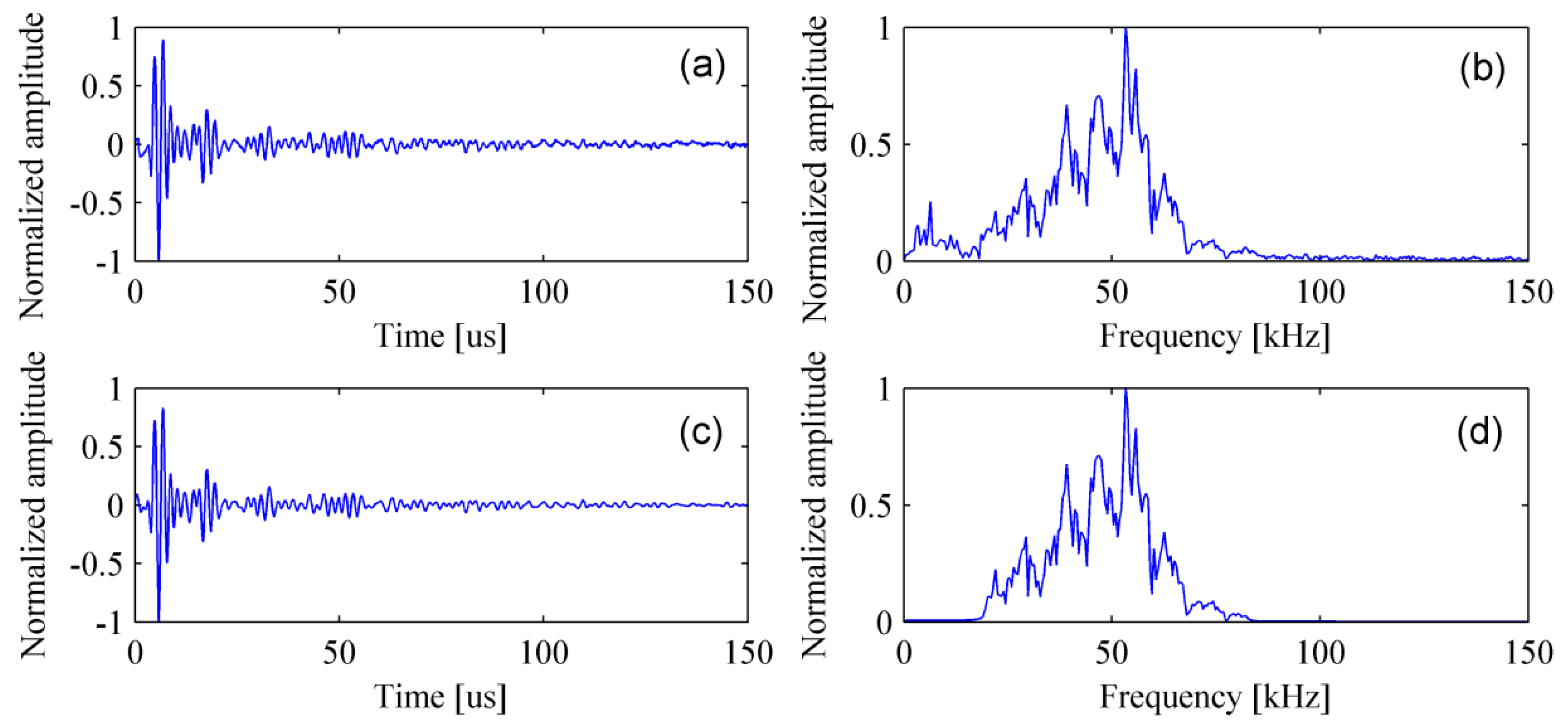


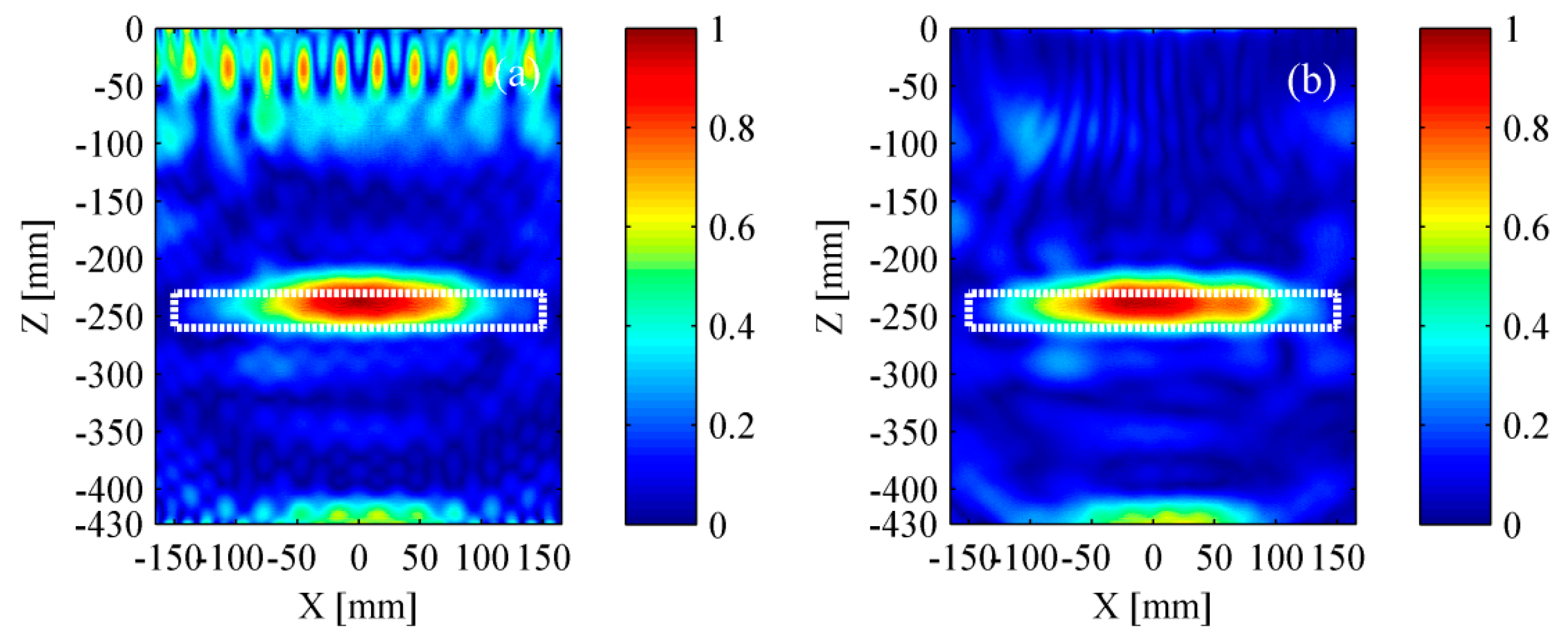
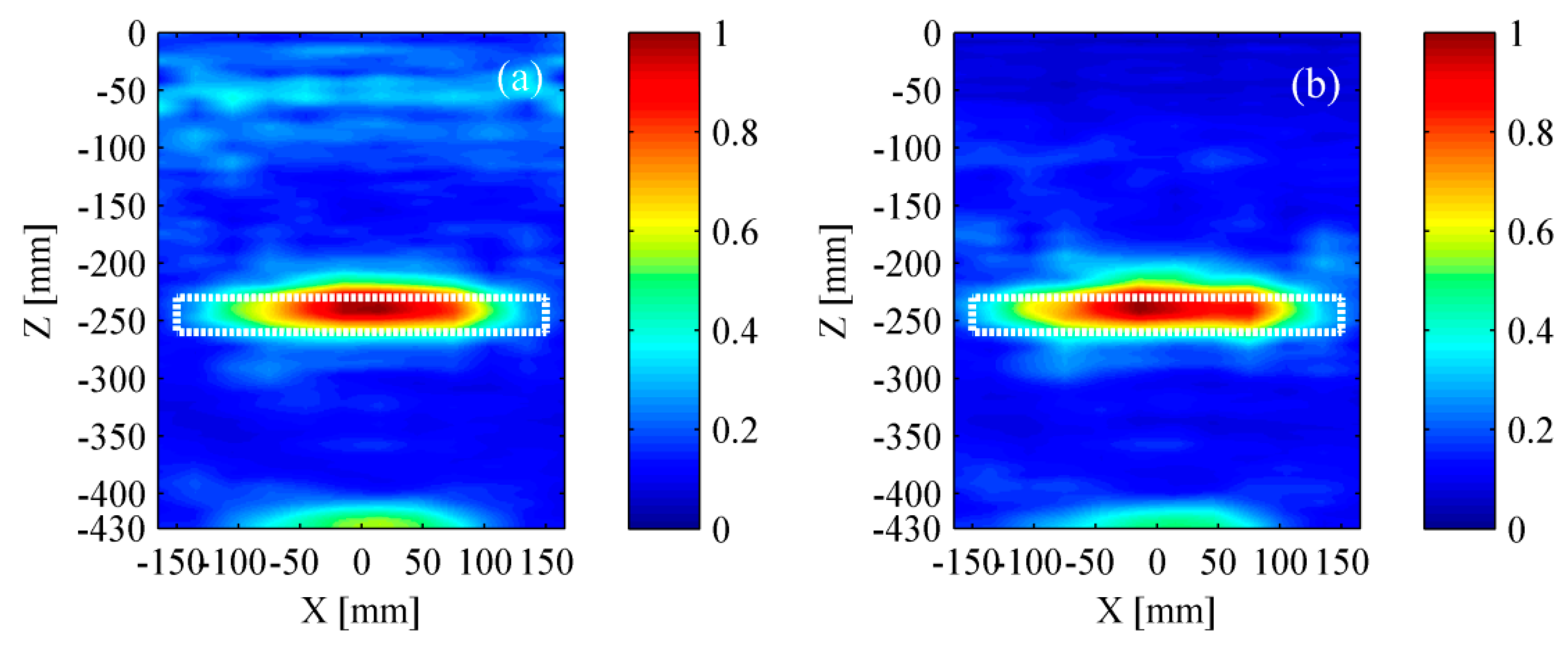

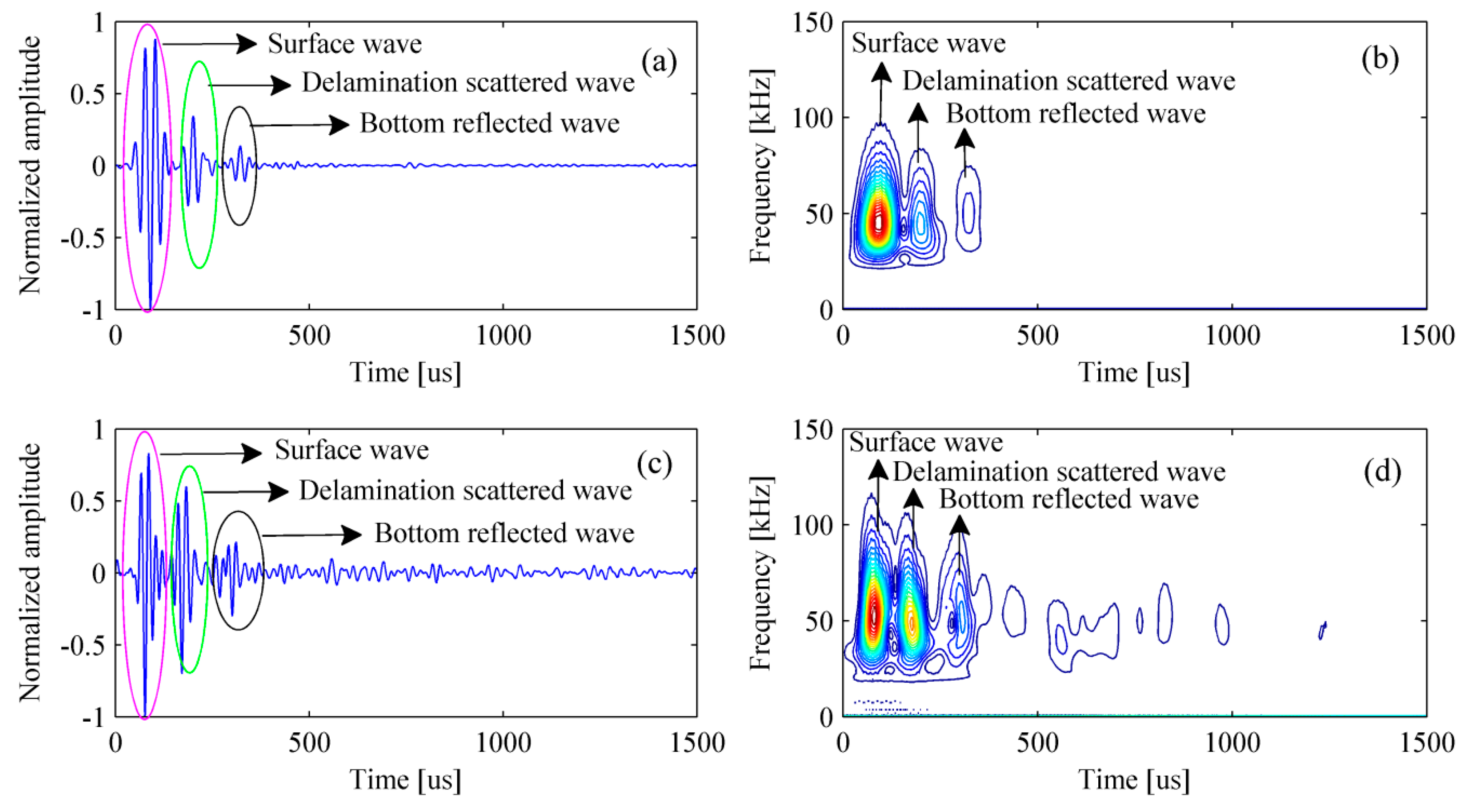
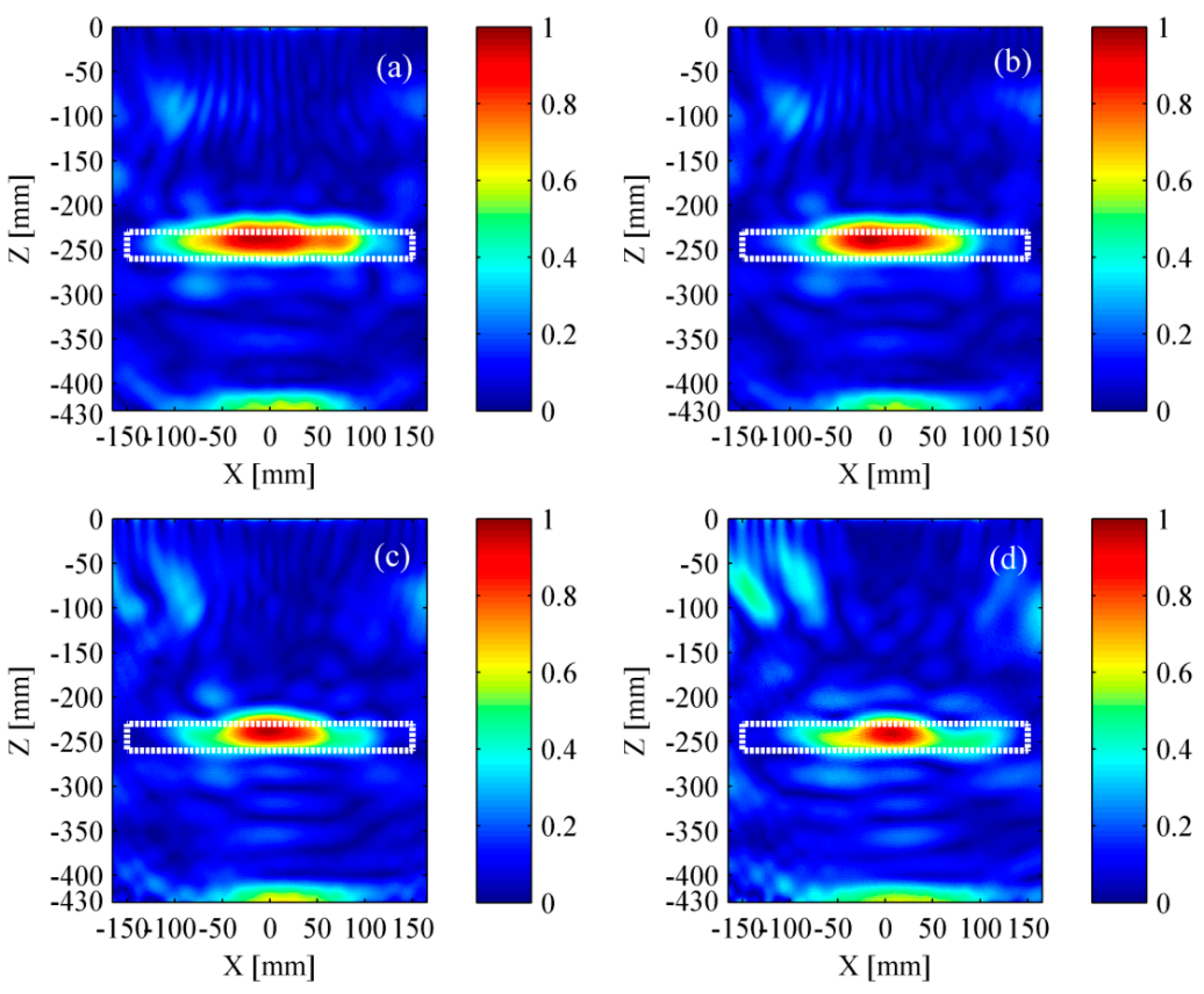
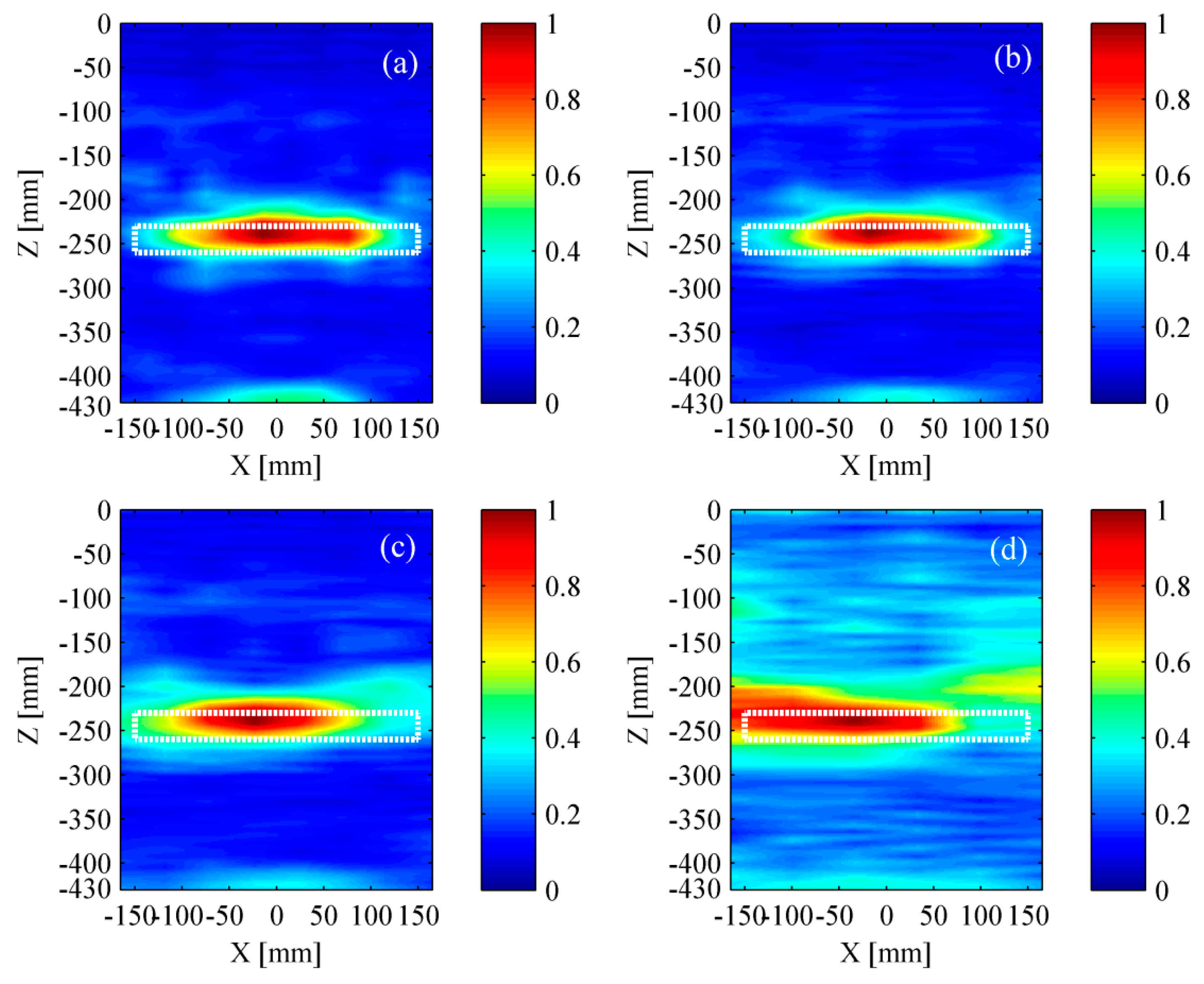
| Property | Slab Track | Self-Compacting Concrete Layer | Bed Plate | Subgrade |
|---|---|---|---|---|
| Concrete strength | C60 | C40 | C40 | / |
| Density (kg/m3) | 2500 | 2500 | 2500 | 1850 |
| Elasticity modulus (Gpa) | 36.5 | 32.5 | 32.5 | 25 |
| Poisson’s ratio | 0.2 | 0.2 | 0.2 | 0.35 |
| Thickness (mm) | 200 | 60 | 170 | 200 |
| Velocity of shear wave | 2466 | 2377 | 2377 | 2237 |
| Property | Value |
|---|---|
| Amount of transducers | 12 |
| Central distance between adjacent transducers (mm) | 30 |
| Central frequency of the excitation signal (kHz) | 50 |
| Bandwidth by the level −6 dB (kHz) | 20–80 |
| Method | Delamination Length (mm) | Delamination Thickness (mm) |
|---|---|---|
| TFM | 201 | 45 |
| Wavenumber method | 234 | 49 |
© 2019 by the authors. Licensee MDPI, Basel, Switzerland. This article is an open access article distributed under the terms and conditions of the Creative Commons Attribution (CC BY) license (http://creativecommons.org/licenses/by/4.0/).
Share and Cite
Fan, G.; Zhang, H.; Zhu, W.; Zhang, H.; Chai, X. Numerical and Experimental Research on Identifying a Delamination in Ballastless Slab Track. Materials 2019, 12, 1788. https://doi.org/10.3390/ma12111788
Fan G, Zhang H, Zhu W, Zhang H, Chai X. Numerical and Experimental Research on Identifying a Delamination in Ballastless Slab Track. Materials. 2019; 12(11):1788. https://doi.org/10.3390/ma12111788
Chicago/Turabian StyleFan, Guopeng, Haiyan Zhang, Wenfa Zhu, Hui Zhang, and Xiaodong Chai. 2019. "Numerical and Experimental Research on Identifying a Delamination in Ballastless Slab Track" Materials 12, no. 11: 1788. https://doi.org/10.3390/ma12111788
APA StyleFan, G., Zhang, H., Zhu, W., Zhang, H., & Chai, X. (2019). Numerical and Experimental Research on Identifying a Delamination in Ballastless Slab Track. Materials, 12(11), 1788. https://doi.org/10.3390/ma12111788





